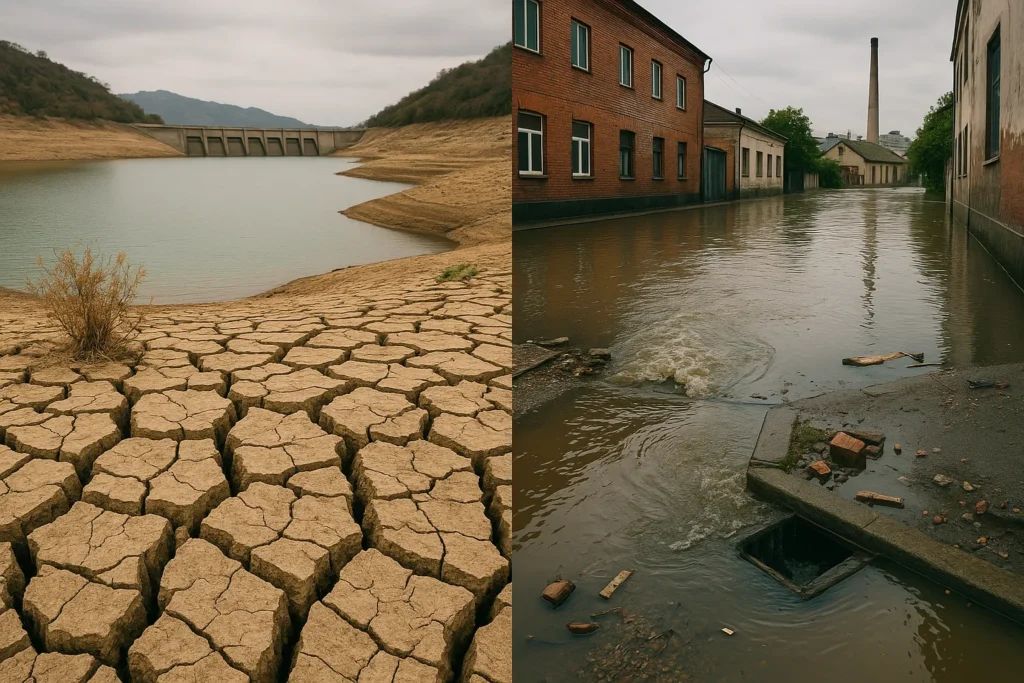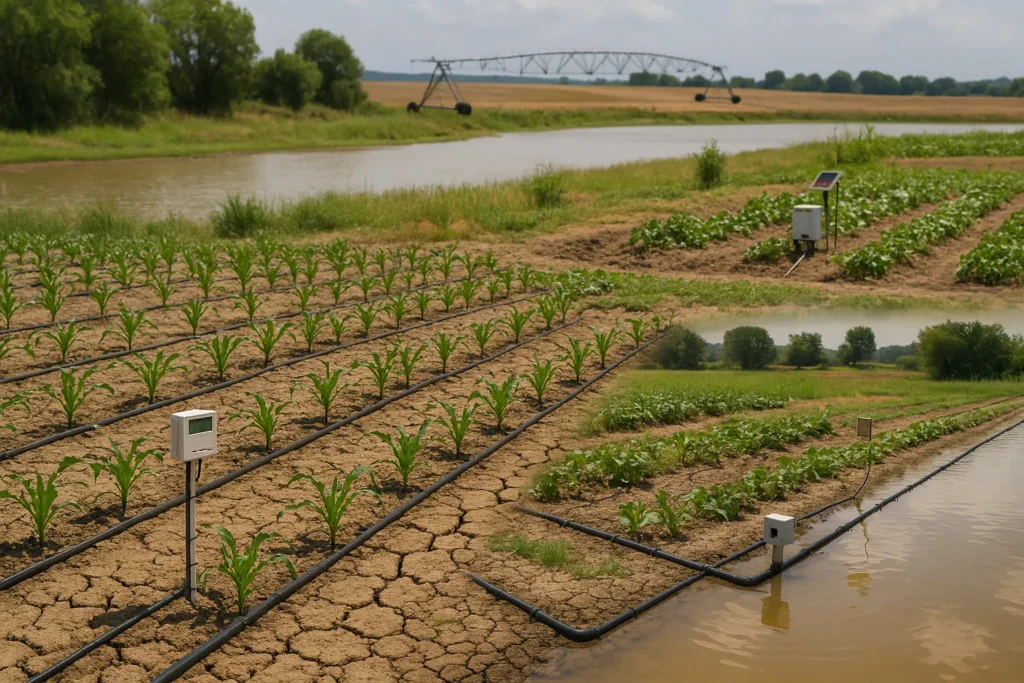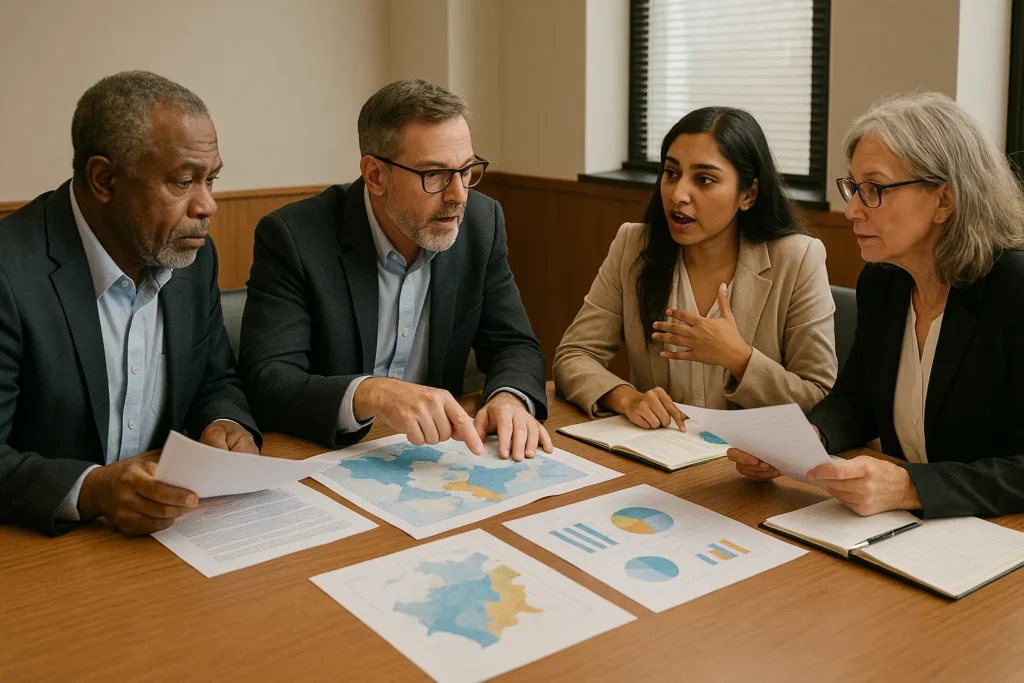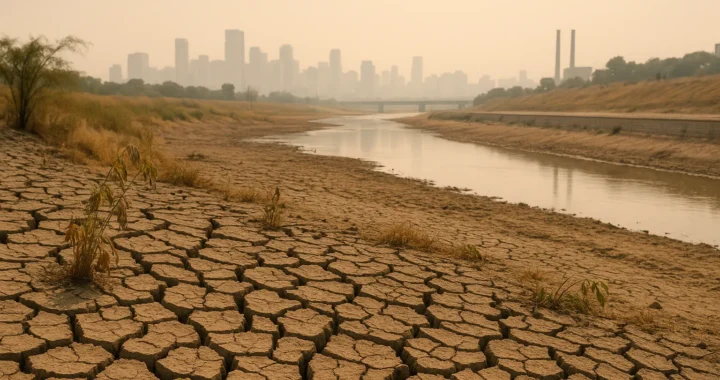Over two billion people already live in countries with an inadequate water supply. And here in 2025, nearly half the world’s population is facing water scarcity. This is the present we are living in, rather than a projection from the past.
Climate change is putting enormous pressure on already-strained systems. Rising temperatures, erratic rainfall, shrinking glaciers, and sea-level rise are disrupting when and where clean water is available.
Also, water shortages are affecting health, food security, education, and daily life across continents.
In this article, we’ll cover the science behind these changes. You’ll see how water scarcity is developing in different parts of the world. We’ll also discuss promising technologies and understand the steps being taken, both globally and locally, to secure future supplies.
Read on to learn more.
How Climate Change Disrupts the Water Cycle
Climate change is hampering the balance of our water cycle. As global temperatures rise, evaporation speeds up. More water is pulled from land and oceans into the air.
But instead of returning evenly as rainfall, it now falls in intense bursts or not at all. The outcome is sudden floods, longer dry spells, and less predictable seasons.
Snowpack in colder regions is also shrinking. Less snow means less meltwater feeding rivers and reservoirs. On top of that, warmer temperatures are causing glaciers to retreat.
These changes alter the timing and amount of water flowing downstream, which leaves communities short during hotter months.
Climate change intensifies extreme conditions further. Droughts are lasting longer, and floods are becoming more severe.
When rain does fall, it often overwhelms soil and infrastructure, which causes damage instead of replenishment. Drying aquifers and overloaded storm systems are proof of the effects of global warming.
Pro Tip: Use tools like NASA’s Earth Observatory or CSIRO’s Water Forecasting and Monitoring to visualise these patterns and share them in presentations or classroom discussions.
How Droughts and Floods Impact Global Water Access
Across the globe, climate-driven droughts and floods are making fresh water harder to find and keep clean. These extreme events are becoming more frequent and more damaging, especially in regions already under pressure.
Below are important examples showing how water scarcity climate conditions are transforming lives and landscapes.
Real Examples of Climate-Driven Water Disasters
In some regions, long dry spells are drying out key water sources, while in others, intense flooding is washing away homes and infrastructure.
Let’s take a look at some of the most striking examples.
- Murray-Darling Basin, Australia: Prolonged drought in this vital farming region has severely reduced river flows and groundwater levels. Wetlands have dried up, and mass fish deaths have occurred. Farmers have faced crippling losses, while towns downstream have enforced strict water restrictions.
- Pakistan Floods, 2022: Catastrophic monsoon flooding covered one-third of the country. Over 8 million people were displaced. The floods damaged water systems and led to outbreaks of cholera and other diseases. Many communities were cut off from clean drinking water and sanitation.
How Climate Events Reduce Freshwater Supply
Droughts and floods interfere with the natural systems we rely on to collect, store, and clean water. These disruptions affect both how much freshwater is available and whether it’s safe to use.

When natural buffers are broken, the result is less water and more contamination. Here’s how these events interfere with freshwater availability.
- Shrinking reservoirs: Extended droughts lower the levels of surface water stored in lakes and dams. This reduces supply for households, farming, and hydropower. In 2021, California’s Lake Oroville dropped to just 20 per cent of its capacity, forcing the shutdown of a major hydroelectric plant for the first time. Once depleted, large reservoirs can take years to fully recover.
- Declining groundwater recharge: Without regular, gentle rainfall and healthy soil cover, aquifers don’t refill as they should. This invisible supply loss can trigger long-term water scarcity. In India’s Punjab and Haryana regions, falling monsoon rainfall and over-pumping have pushed groundwater to critical lows, threatening both food production and daily drinking water needs.
- Flood contamination: When storms strike hard, drainage and sewage systems often fail. That sends waste, chemicals, and debris straight into water sources. For instance, after Hurricane Harvey hit Texas in 2017, floodwaters spread untreated sewage, oil, and industrial waste into local rivers, increasing the risk of disease and damaging ecosystems.
These real-world examples show how the global warming effects on water are already straining infrastructure and natural systems.
Water Scarcity: Climate Risks to Food and Health
Safe and steady water supplies are closely linked to public health and food production. When floods or droughts interrupt access, the impact is felt in hospitals, markets, and homes.
Here’s how these impacts are unfolding on the ground.
- Crop loss: Drought conditions prevent plants from growing, and floods wipe out entire harvests. Less food means higher prices and growing pressure on food supply chains.
- Health risks: Without enough clean water, hygiene suffers, and waterborne illnesses spread quickly. These risks are highest in low-income areas with weak infrastructure and limited medical care.
- Urban strain: Cities may face supply cuts, increased water costs, and damaged infrastructure. Aging water systems are especially vulnerable to pressure caused by extreme weather.
Climate change water disruptions are affecting regions of all income levels. Both large cities and rural villages are facing challenges to their water safety and security.
Drawing from our experience covering environmental crises, communities hit hardest are commonly the least prepared. That’s why timely action and local resilience planning are so important.
Local Case Study: Australia’s Climate Challenge
Australia is no stranger to dry spells, but recent patterns show something deeper at play. Long-term climate impacts are weakening the country’s natural water systems and exposing major gaps in how water is managed.
Rainfall patterns have changed significantly in recent decades. Sydney and Brisbane have seen lower average rainfall and weaker inflows into major reservoirs. According to the Australian Bureau of Meteorology, streamflows in eastern catchments have dropped, closely tied to warming trends and changes in seasonal rainfall.
In rural areas, many farming communities are turning to groundwater as rivers run dry. Deeper bores and higher pumping costs are pushing the limits of what small towns can afford.
Meanwhile, desalination plants have helped during drought years, but they are expensive and energy-intensive. They support urban supply but can’t replace natural sources across broader regions.
Many places are facing dire consequences as we write this. Water bills have risen, and rural areas face tougher restrictions, which creates a growing divide in access and affordability.
Water Tech Solutions for a Changing Climate
What happens when the old ways of managing water no longer keep up with the weather?
Rising heat and fluctuating rainfall patterns are forcing communities to rethink how water is collected, stored, and shared. These solutions are already helping farms, households, and cities respond to the growing demands on our most essential resource.
Smart Irrigation Tools Reduce Water Waste
Water-efficient farming is essential in regions facing regular droughts and shrinking water reserves. Smart irrigation systems are helping reduce overwatering by monitoring soil conditions and adjusting supply based on real-time data.

Let’s take a look at how these tools are being used in both large and small-scale settings.
- Large-scale use: In California’s Central Valley, farms are using advanced irrigation platforms that combine soil sensors with satellite weather data. These systems help save up to a quarter of the amount of water while supporting higher crop yields during dry seasons.
- Small-scale use: In India’s Maharashtra region, solar-powered drip kits are helping smallholder farmers water crops consistently despite erratic rainfall. The simple design keeps costs low and allows for long-term use without relying on grid electricity.
Harvesting Water from the Air
In dry climates, fog nets and atmospheric water generators are helping fill the gap when surface water is scarce. These technologies collect airborne moisture and convert it into usable drinking water.
Here’s how these systems are helping communities tap into the air for survival.
- Example: In the Moroccan desert, community-run fog net systems are capturing moisture from ocean breezes and producing over 6,000 litres of clean water each day. Maintenance is handled locally, keeping the system reliable and accessible.
- Household tech: Compact water-from-air systems are being piloted in remote parts of Kenya and Chile. These devices produce up to 500 litres of water per day using built-in condensation units, enough to meet daily drinking needs for small households.
AI for Smarter Water Infrastructure Monitoring
Ageing pipes and unnoticed leaks waste massive amounts of treated water. AI-enabled systems can monitor pressure and flow in real time to detect problems early and keep water systems running efficiently.
Here’s how smart sensors are improving water infrastructure worldwide.
- Case in progress: Singapore’s water utility uses AI and pressure sensors to track vulnerabilities across the water grid. The system predicts breaks before they happen, reducing leakage to under 5 per cent, a benchmark for global efficiency.
- Emerging tools: Thames Water in the UK is testing AI tools that analyse flow patterns and detect small leaks through sound signals. Early detection allows for quicker repairs and avoids major service disruptions.
Matching Water Solutions to Local Needs
Water solutions vary widely depending on location, infrastructure, and available resources. Some regions rely on automated systems, while others benefit more from simple tools that are easy to build and maintain.
Here’s how different regions are applying solutions that match their local needs.
- High-tech model: Israel recycles nearly 90% of its wastewater through advanced treatment systems. This reclaimed water supports the country’s agricultural needs and reduces pressure on freshwater reserves.
- Low-tech approach: In rural Laos, villages use gravity-fed rainwater tanks combined with biosand filters to meet basic water needs. These systems are affordable, community-run, and resilient to power cuts or supply chain delays.
Our analysis has shown that successful solutions always match local conditions and priorities. No matter how advanced a technology is, it must be supported by people who understand how to use and care for it.
Why Water Policy Must Support Climate Change Action
Climate change is accelerating water stress, and outdated or inconsistent frameworks leave communities vulnerable to droughts, floods, and unequal access.

Updated policies create the structure for how water is managed, who is accountable, and what actions are prioritised when resources run low. Stronger laws are also helping to create lasting protection.
Without strict water governance, climate plans fall short when tested. Here are the key areas where current policies need to improve:
- Legal backing to ensure action: Clear laws and enforceable regulations turn climate change water goals into results. Without legal frameworks, promises tend to fade without implementation.
- Many plans with little connection: Water policies are often scattered across departments or regions, leading to overlap, confusion, or inaction during times of water stress.
- Global efforts: Initiatives like the UN Water Action Decade (2018–2028) aim to boost cooperation and sustainable use, but progress depends on how nations apply these frameworks locally.
- Enforcement and transparency fall short: Many countries lack reliable monitoring systems or the authority to penalise overuse and pollution. Weak data collection makes it hard to track impact or build public trust.
The strongest water policies are designed with equity, sustainability, and enforceability in mind.
Global Water Partnerships to Tackle Shared Challenges
Global partnerships involve countries working together to manage supply, reduce conflict, and build resilience across regions. Water scarcity and the global warming effects behind it do not stop at national borders. Rivers, lakes, and underground aquifers often stretch across countries, making shared resources a shared responsibility.
Managing Cross-Border Water in a Changing Climate
Many water systems are shared between nations. When one country changes how it uses or stores water, others feel the impact. Managing shared rivers, lakes, and aquifers requires clear agreements and consistent cooperation.
Let’s take a look at where these challenges are showing up and how shared agreements help manage them.
- Cross-border resources need coordination: More than 260 river basins stretch across multiple countries. The Nile Basin, which touches 11 nations, has seen long-running disputes over dam construction and water rights.
- Cooperation sets the standard: The EU Water Framework Directive gives neighbouring countries a structure for managing shared resources. It encourages joint decisions, monitoring, and pollution control.
Sharing Data and Support to Ease Water Scarcity
When countries share data and resources related to water management, they can help each other respond faster and more fairly to rising pressures.
Here’s how stronger data and global support can improve outcomes for everyone.
- Climate risks are uneven but connected: Drought in one country can affect food prices or migration elsewhere. Open access to risk data helps governments make better decisions and prepare before problems escalate.
- Equity matters: Well-resourced nations can play a vital role by funding infrastructure, training, and tools in lower-income regions that face the most severe water scarcity climate challenges.
Water diplomacy is becoming as critical to international relations as oil and energy deals once were.
Everyday Actions to Support Climate Change Water Goals
There are a few things you can do to help improve water conservation.
Simple steps at home, in your garden, through shopping habits, and during elections can help ease pressure on water systems and support long-term solutions. These actions are pragmatic and accessible for anyone who wants to be part of the change.

Here are five practical ways you can make a positive impact starting today:
- At home: Repair leaking taps and toilets promptly. Even a slow drip can waste thousands of litres each year. Replacing old fixtures with water-efficient models helps reduce daily use without requiring major lifestyle changes.
- In the yard: Choose plants that suit your local climate, especially native or drought-tolerant species. Water during cooler times of the day to reduce loss from evaporation. Use drip irrigation to deliver water directly to plant roots.
- In the shops: Support brands that show measurable progress in water conservation and responsible sourcing. Look for sustainability reports or certifications that confirm their commitments.
- In your community: Contribute to organisations like Water.org or WaterAid Australia. These groups expand access to clean water and run education programs that build long-term awareness.
- At the polls: Learn where candidates stand on water and climate policies. Vote for leaders who support infrastructure upgrades, resource protection, and climate-smart planning.
Every action you take contributes to a stronger, more sustainable water future. They help protect water where you live while supporting people in places facing much harder conditions.
Take Action Against the Growing Climate Impact on Water
Climate change is transforming our relationship with water. It influences where water comes from, how reliably we can access it, and what happens when those systems are under stress.
In this article, we’ve seen how changing weather patterns disrupt supply, how droughts and floods affect both quality and availability, and why forward-thinking plans are more important than ever.
However, there is reason for hope, as new technologies are helping us use water more efficiently, and strong policies create the structure for lasting change.
This is the time to take that next step. At Easy510, we work to improve clean water access, support sustainable innovation, and deliver education where it matters most. Visit our website to learn how you can get involved.

